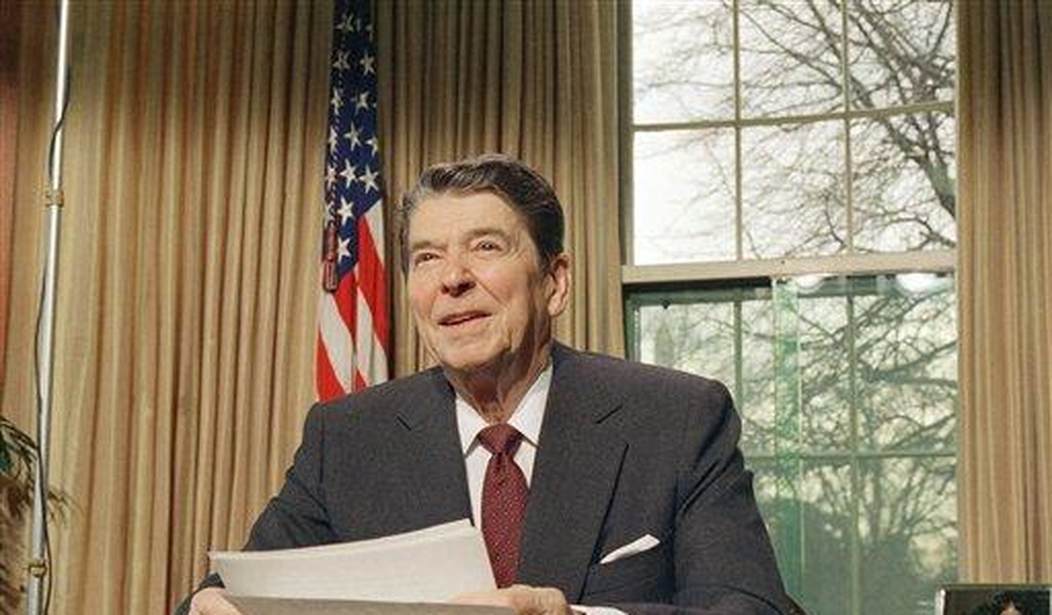Despite ample evidence that America's deficit spending has not resulted in a healthy, growing economy, an election-wary Congress is still very likely to increase spending and debt this year.
Ronald Reagan, who was born 103 years ago on Feb. 6, had better ideas about how to increase prosperity – unleashing the power of the private sector by restraining government and cutting taxes.
In celebration of the Gipper's birthday, Townhall is featuring a series of concise examples of Mr. Reagan's wisdom, mostly in his own words, drawn from The Reagan Resolve, a monograph compiled by the Carleson Center for Welfare Reform.
“A Fundamentally Different Course”
The economic, fiscal, and constitutional crisis confronting our country today is eerily similar to the one America faced when Reagan campaigned against President Jimmy Carter in 1980. As Reagan summed it up after his Presidency in his autobiography:
“It was a rebellion of ordinary people. A generation of middle-class Americans who had worked hard to make something of their lives was growing mistrustful of a government that took an average of thirty-seven cents of every dollar they earned and still plunged deeper into debt every day.
“There was a growing sense of helplessness and frustration across the country over a government that was becoming a separate force of its own, a master of the people, not the other way around.
“People were growing resentful of bureaucrats whose first mission in life seemed to be protecting their own jobs by keeping expensive programs alive long after the usefulness had expired. They were losing respect for politicians who kept voting for open-ended welfare programs riddled with fraud and inefficiency that kept generation after generation of families dependent on the dole. And they were growing mistrustful of the self-appointed intellectual elite back in Washington who claimed to know better than the people of America and their communities.”
Recommended
[“An American Life” by Ronald Reagan, p. 232]
Ronald Reagan’s fiscal and governmental prescription for American renewal and recovery worked in the 1980s and launched more than 25 years of economic prosperity. The same prescription can work magic again in 2012, because it is based on the timeless wisdom of our Founding Fathers.
Ronald Reagan’s stature continues to grow, and it has reached a point where all sorts of people invoke his name to support their policies or candidacies – even liberals. With our nation at a crossroads, and in desperate need of the kind of leadership that President Reagan afforded us, it’s important to set the record straight about what he stood for.
At the core of Mr. Reagan’s successful governance was a commitment to a strong national security, traditional values, genuine federalism and domestic policies designed to restore America as an entrepreneurial powerhouse.
In a message to Congress less than a month after taking office, President Reagan described the comprehensive economic recovery package he proposed for a full and vigorous recovery and “to put the nation on a fundamentally different course leading to less inflation, more growth, and a brighter future for all of our citizens.”
“ —A budget reform plan to cut the rate of growth in Federal spending;
—A series of proposals to reduce personal income tax rates by 10 percent a year over three years and to create jobs by accelerating depreciation for business investment in plant and equipment;
—A far-reaching program of regulatory relief;
—And, in cooperation with the Federal Reserve Board, a new commitment to a monetary policy that will restore a stable currency and healthy financial markets.”
[Message to the Congress Transmitting the Proposed Package on the Program
for Economic Recovery, Feb. 18, 1981]
This common sense, four-point plan resulted in the most successful economic experiment in world history – setting a new record for the longest peacetime expansion ever. Reagan’s solutions reduced inflation from almost 13% when he took office in 1981 to 3.2% in 1983.
Over his two terms in office, Mr. Reagan’s policies added nearly 20 million new jobs, reducing unemployment by over half from 10.8% in 1982 to 5.3% in 1989. The bottom 20% of earners also benefited. Their average household income grew by 12.2% from 1983 to 1989.
The poverty rate, which had been increasing under President Carter, declined every year under Reagan while the standard of living for all Americans rose by almost 20%.
Reagan's opponents who had argued that his tax cuts would increase interest rates were proven wrong. The prime rate was cut by two-thirds, down to 8.2% in 1987 and then to 6.25% by 1992. The stock market more than tripled in value from 1980 to 1990 – the largest decade-long increase in history.
It is important to remember that the Founding Fathers’ belief in federalism was revered by Ronald Reagan. That uniquely American doctrine united 13 colonies into “these United States” by recognizing each state as its own sovereign government within a sovereign national government. As Reagan put it in 1982, in an address to the National Association of Counties Convention:
“The more government we can keep at the local levels, in local hands, the better off we are and the more freedom we will have…. In the recent past, as the Federal Government has pushed each city, county, and State to be more like every other, we’ve begun to lose one of our greatest strengths — our diversity as a people. …We’ve lost the sense of which problems require national solutions and which are best handled at the local level.”
[Remarks at the National Assn. of Counties Convention, Baltimore, July 13, 1982]
Reagan’s belief in federalism was the motivation for his administration’s efforts to cut red tape, deregulate the economy, reduce federal spending, and devolve governmental power to the states:
“When our administration came to office, we took it as one of our chief aims to reawaken the federalist impulse and approach the Constitution with a new fidelity — in short, to restore the power to the states.”
[Remarks to the National Conference of State Legislators on Jan. 29, 1988]
Ronald Reagan also recognized that the expansion of the welfare state was the greatest threat to federalism and fighting it was a driving force throughout his political career. He testified as Governor to the Senate Finance Committee in 1972: “I consider the welfare problem the gravest domestic issue our Nation faces.”
[Testimony of Gov. Ronald Reagan to the U.S. Senate Finance Committee, Feb. 1, 1972, pp. 1-2]
As Governor, Reagan discovered he was greatly hampered by federal welfare rules and policies. But, working with his welfare reform champion Robert B. Carleson, Reagan was still able to achieve great savings for the state’s taxpayers and better serve the poor by focusing assistance to those most truly in need. His views about welfare were clear as far back as 1968 when he addressed the Governor’s Conference on Medicaid:
“Welfare needs a purpose: to provide for the needy, of course, but more than that, to salvage these, our fellow citizens, to make them self-sustaining and, as quickly as possible, independent of welfare. There has been something terribly wrong with a program that grows ever larger even when prosperity for everyone else is increasing. We should measure welfare’s success by how many people leave welfare, not by how many are added.”
[Remarks at Governor’s Conference on Medicaid, San Francisco, 1968]
The Reagan Resolve is a reminder of America’s animating principles and a roadmap to steer us off an unthinkable acceleration down The Road to Serfdom, a socialistic morass described so well in that book by one of Mr. Reagan’s favorite economists, F.A. Hayek.
We have arrived at a transcendent moment in our history and Americans must choose a path. Will we take the easy path and let government take care of us and make more and more of our decisions for us? Or, will we take the difficult path - the path that Ronald Reagan chose - and fight to remain a free market society and a liberty-loving people? Thirty-three years ago, Ronald Reagan showed us how to do it. Now it's up to us to have the resolve to do it again.
See full text of The Reagan Resolve and source documents for Reagan’s quotes at http://theccwr.org/ReaganResolve.html.
For more information, see the Carleson Center for Welfare Reform at http://theccwr.org/.

























Join the conversation as a VIP Member